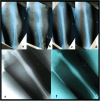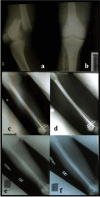Standard or Fin SIGN® nail? which option is better for the treatment of femoral fractures in low and middle-income countries?
- PMID: 38761212
- PMCID: PMC11246262
- DOI: 10.1007/s00264-024-06192-7
Standard or Fin SIGN® nail? which option is better for the treatment of femoral fractures in low and middle-income countries?
Abstract
Purpose: Femoral fractures are common in low and middle-income countries (LMIC), predominantly caused by high-energy trauma. The surgical implant generation network (SIGN®) program offers two different intramedullary nails in LMIC which are designed to be used without image intensifier free of charge for the patients: the SIGN standard nail (SSN®) and the SIGN Fin nail (SFN®). This study aimed to compare the results of the SSN® and the SFN® for the treatment of middle and distal shaft femoral fractures through a retrograde approach.
Material and methods: This was a retrospective, descriptive, and non-experimental study including all consecutive patients who underwent surgical management of middle or distal shaft femoral fracture between January 2017 and May 2022 in an NGO hospital located in Freetown, Sierra Leone. The duration of surgery, type of reduction, complications like screw loosening, implant migration, anterior knee pain and non-union rate at six months of follow up were evaluated.
Results: A total of 122 patients were included in the study. Group A: 60 patients were managed with SSN® and Group B: 62 patients with SFN®. The mean operative time was 104 min with SSN® and 78 with SFN® (p < 0.001). Open reduction of the fracture was necessary in ten (16.7%) patients with SSN® and 12 (19.4%) patients treated with SFN® (p = 0.69). Non-union was observed in one (1.7%) patient with SSN® and two (3.2%) patients with SFN® (p = 0.57).
Conclusions: Both options seem equally effective in treating midshaft and distal femoral shaft fractures. The SFN® reduces the surgical time, due to this fact, in polytraumatized patients, patients with bilateral femur fracture or patients with ipsilateral tibia fracture, it can be considered as the best option to be used. There was no statistical difference in the complications presented by the two groups.
Keywords: Developing countries; Femoral fractures; Intramedullary fracture fixation; Orthopedic surgery.
© 2024. The Author(s).
Conflict of interest statement
None.
Figures





Similar articles
-
Surgical Implant Generation Network (SIGN) Fin nail versus SIGN standard intramedullary nail for distal diaphyseal femur fractures treated via retrograde approach.Injury. 2019 Oct;50(10):1725-1730. doi: 10.1016/j.injury.2019.09.009. Epub 2019 Sep 9. Injury. 2019. PMID: 31540799
-
Femoral fracture fixation in developing countries: an evaluation of the Surgical Implant Generation Network (SIGN) intramedullary nail.J Bone Joint Surg Am. 2011 Oct 5;93(19):1811-8. doi: 10.2106/JBJS.J.01322. J Bone Joint Surg Am. 2011. PMID: 22005867
-
Retrograde versus antegrade nailing of femoral shaft fractures.J Orthop Trauma. 2001 Mar-Apr;15(3):161-9. doi: 10.1097/00005131-200103000-00003. J Orthop Trauma. 2001. PMID: 11265005
-
Evaluation of Intramedullary Fixation for Pediatric Femoral Shaft Fractures in Developing Countries.J Orthop Trauma. 2018 Jun;32(6):e210-e214. doi: 10.1097/BOT.0000000000001131. J Orthop Trauma. 2018. PMID: 29432321
-
[Comparison of proximal femoral nail antirotation and reconstruction nail for ipsilateral fractures of hip and femoral shaft].Zhongguo Xiu Fu Chong Jian Wai Ke Za Zhi. 2012 Aug;26(8):905-9. Zhongguo Xiu Fu Chong Jian Wai Ke Za Zhi. 2012. PMID: 23012919 Chinese.
Cited by
-
Outcomes of external versus internal fixation for traumatic lower limb fractures in low- and middle-income countries.Bone Jt Open. 2024 Nov 11;5(11):1020-1026. doi: 10.1302/2633-1462.511.BJO-2024-0163. Bone Jt Open. 2024. PMID: 39522553 Free PMC article.
References
Publication types
MeSH terms
LinkOut - more resources
Full Text Sources
Medical
Research Materials
Miscellaneous

